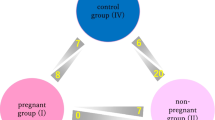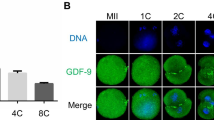Abstract
Purpose
To study embryo morphokinetics in relation to release in spent media of molecules with possible roles in development and implantation (miR-20a, miR-30c, and sHLA-G).
Methods
Data were obtained from embryos generated in standard IVF and ICSI cycles. The Eeva system was used for embryo assessment, based on early morphokinetic parameters and producing a score (1–5, best–worst) corresponding to higher/medium/lower chances of development to blastocyst. miRNAs — mm miR-20a-5p and miR-30c-5p — and sHLA-G were quantified in 25 μl of spent blastocyst media (SBM) collected before vitrification or transfer. Statistical analyses were performed applying Kolmogorov-Smirnov, Shapiro-Wilk, and Spearman’s correlation coefficient tests, where appropriate.
Results
SBM were collected from a total of 172 viable blastocysts. Their analysis showed that concentration of miR-20a was progressively lower as Eeva score increased and probability of development to blastocyst decreased (P = 0.016). The opposite trend was observed in the case of miR-30c, i.e., concentration was higher as score increased and chances of development to blastocyst decreased (P = 0.004). Analysis of sHLA-G revealed a negative correlation with Eeva score, i.e., levels were progressively lower as Eeva score increased and probability of development to blastocyst decreased (R = − 0.388, N = 141, P = 0.001).
Conclusion
Our data suggest that morphokinetic algorithms that predict development to blastocyst stage, in fact, also identify embryos with molecular and cellular profiles more consistent with developmental functions.
Similar content being viewed by others
References
Meseguer M, Herrero J, Tejera A, Hilligsøe KM, Ramsing NB, Remoh J. The use of morphokinetics as a predictor of embryo implantation. Hum Reprod. 2011;26:2658–71.
Basile N, Nogales MDC, Bronet F, Florensa M, Riqueiros M, Rodrigo L, et al. Increasing the probability of selecting chromosomally normal embryos by time-lapse morphokinetics analysis. Fertil Steril. 2014;101:699–704.e1.
Basile N, Vime P, Florensa M, Aparicio Ruiz B, García Velasco JA, Remohí J, et al. The use of morphokinetics as a predictor of implantation: a multicentric study to define and validate an algorithmfor embryo selection. Hum Reprod. 2015;30:276–83.
Rubio I, Kuhlmann R, Agerholm I, Kirk J, Herrero J, Escribá MJ, et al. Limited implantation success of direct-cleaved human zygotes: a time-lapse study. Fertil Steril. 2012;98:1458–63.
Petersen BM, Boel M, Montag M, Gardner DK. Development of a generally applicable morphokinetic algorithm capable of predicting the implantation potential of embryos transferred on Day 3. Hum Reprod. 2016;31:2231–44.
Kirkegaard K, Campbell A, Agerholm I, Bentin-Ley U, Gabrielsen A, Kirk J, et al. Limitations of a time-lapse blastocyst prediction model: a large multicentre outcome analysis. Reprod BioMed Online. 2014;29:156–8.
Apter S, Ebner T, Freour T, Guns Y, Kovacic B, Le Clef N, et al. Good practice recommendations for the use of time-lapse technology†. Hum Reprod Open. 2020;2020:1–26.
Coticchio G, Renzini MM, Novara PV, Lain M, De Ponti E, Turchi D, et al. Focused time-lapse analysis reveals novel aspects of human fertilization and suggests new parameters of embryo viability. Hum Reprod. 2018;33:23–31.
McCoy RC, Newnham LJ, Ottolini CS, Hoffmann ER, Chatzimeletiou K, Cornejo OE, et al. Tripolar chromosome segregation drives the association between maternal genotype at variants spanning PLK4 and aneuploidy in human preimplantation embryos. Hum Mol Genet. 2018;27:2573–85.
Lagalla C, Tarozzi N, Sciajno R, Wells D, Di Santo M, Nadalini M, et al. Embryos with morphokinetic abnormalities may develop into euploid blastocysts. Reprod Biomed Online [Internet]. Elsevier Ltd; 2017;34:137–46. Available from: https://doi.org/10.1016/j.rbmo.2016.11.008
Conaghan J, Chen AA, Willman SP, Ivani K, Chenette PE, Boostanfar R, et al. Improving embryo selection using a computer-automated time-lapse image analysis test plus day 3 morphology: Results from a prospective multicenter trial. Fertil Steril. 2013;100:412–419.e5.
Cimadomo D, Rienzi L, Giancani A, Alviggi E, Dusi L, Canipari R, et al. Definition and validation of a custom protocol to detect miRNAs in the spent media after blastocyst culture: Searching for biomarkers of implantation. Hum Reprod. 2019;34:1746–61.
Nowak I, Wilczyńska K, Radwan P, Wiśniewski A, Krasiński R, Radwan M, et al. Association of Soluble HLA-G Plasma Level and HLA-G Genetic Polymorphism With Pregnancy Outcome of Patients Undergoing in vitro Fertilization Embryo Transfer. Front Immunol. 2019;10:2982.
Rodríguez Díaz R, Blanes Zamora R, Vaca Sánchez R, González Pérez J, Alberto Bethencourt JC. Embryo sHLA-G secretion is related to pregnancy rate. Zygote. Cambridge University Press. 2019;27:78–81.
Rizzo R, Vercammen M, Van De Velde H, Horn PA, Rebmann V. The importance of HLA-G expression in embryos, trophoblast cells, and embryonic stem cells. Cell Mol Life Sci. 2011;68:341–52.
Fuzzi B, Rizzo R, Criscuoli L, Noci I, Melchiorri L, Scarselli B, et al. HLA-G expression in early embryos is a fundamental prerequisite for the obtainment of pregnancy. Eur J Immunol. 2002;32:311–5.
Zacà C, Bazzocchi A, Pennetta F, Bonu MA, Coticchio G, Borini A. Cumulative live birth rate in freeze-all cycles is comparable to that of a conventional embryo transfer policy at the cleavage stage but superior at the blastocyst stage. Fertil Steril [Internet]. 2018;110:703–9. Available from: https://linkinghub.elsevier.com/retrieve/pii/S0015028218304138.
Lagalla C, Coticchio G, Sciajno R, Tarozzi N, Zacà C, Borini A. Alternative patterns of partial embryo compaction: prevalence, morphokinetic history and possible implications. Reprod Biomed Online [Internet]. Elsevier Ltd; 2020;40:347–54. Available from: https://doi.org/10.1016/j.rbmo.2019.11.011
Liu Y, Chapple V, Roberts P, Matson P. Prevalence, consequence, and significance of reverse cleavage by human embryos viewed with the use of the embryoscope time-lapse video system. Fertil Steril. 2014;102:1295–1300.e2.
Campbell AJ, Fishel SB, Duffy S, Montgomery S. Embryo selection model defined using morphokinetic data from human embryos to predict implantation and live birth. Fertil Steril. 2013;100:S502.
Campbell A, Fishel S, Bowman N, Duffy S, Sedler M, Hickman CFL. Modelling a risk classification of aneuploidy in human embryos using non-invasive morphokinetics. Reprod Biomed Online. 2013;26:477–85.
Tejera A, Castelló D, de los Santos JM, Pellicer A, Remohí J, Meseguer M. Combination of metabolism measurement and a time-lapse system provides an embryo selection method based on oxygen uptake and chronology of cytokinesis timing. Fertil Steril. 2016;106:119–126.e2.
Gebert LFR, MacRae IJ. Regulation of microRNA function in animals. Nat Rev Mol Cell Biol. 2019;20:21–37.
Salas-Huetos A, James ER, Aston KI, Jenkins TG, Carrell DT, Yeste M. The Expression of miRNAs in human ovaries, oocytes, extracellular vesicles, and early embryos: a systematic review. Cells. 2019;8:1–23.
Yuan S, Schuster A, Tang C, Yu T, Ortogero N, Bao J, et al. Sperm-borne miRNAs and endo-siRNAs are important for fertilization and preimplantation embryonic development. Dev. 2016;143:635–47.
Capalbo A, Ubaldi FM, Cimadomo D, Noli L, Khalaf Y, Farcomeni A, et al. MicroRNAs in spent blastocyst culture medium are derived from trophectoderm cells and can be explored for human embryo reproductive competence assessment. Fertil Steril. 2016;105:225–235.e3.
Foshay KM, Gallicano GI. miR-17 family miRNAs are expressed during early mammalian development and regulate stem cell differentiation. Dev Biol [Internet]. Elsevier Inc.; 2009;326:431–43. Available from: https://doi.org/10.1016/j.ydbio.2008.11.016
Lin X, Beckers E, Mc Cafferty S, Gansemans Y, Joanna Szymańska K, Chaitanya Pavani K, et al. Bovine embryo-secreted microRNA-30c is a potential non-invasive biomarker for hampered preimplantation developmental competence. Front Genet [Internet]. Frontiers Media S.A.; 2019 [cited 2020 Aug 14];10:315. Available from: https://www.frontiersin.org/article/10.3389/fgene.2019.00315/full.
Nilsson LL, Djurisic S, Hviid TVF. Controlling the immunological crosstalk during conception and pregnancy: HLA-G in reproduction. Front Immunol. 2014;5:198.
Sher G, Keskintepe L, Nouriani M, Roussev R, Batzofin J. Expression of sHLA-G in supernatants of individually cultured 46-h embryos: a potentially valuable indicator of “embryo competency” and IVF outcome. Reprod BioMed Online. Reproductive Healthcare Ltd. 2004;9:74–8.
Yie SM, Balakier H, Motamedi G, Librach CL. Secretion of human leukocyte antigen-G by human embryos is associated with a higher in vitro fertilization pregnancy rate. Fertil Steril. 2005;83:30–6.
Noci I, Fuzzi B, Rizzo R, Melchiorri L, Criscuoli L, Dabizzi S, et al. Embryonic soluble HLA-G as a marker of developmental potential in embryos. Hum Reprod. Oxford University Press. 2005;20:138–46.
Rebmann V, Switala M, Eue I, Grosse-Wilde H. Soluble HLA-G is an independent factor for the prediction of pregnancy outcome after ART: a German multi-centre study. Hum Reprod. Oxford University Press. 2010;25:1691–8.
Kotze D, Kruger TF, Lombard C, Padayachee T, Keskintepe L, Sher G. The effect of the biochemical marker soluble human leukocyte antigen G on pregnancy outcome in assisted reproductive technology - a multicenter study. Fertil Steril. 2013;100:1303–9.
Acknowledgements
This research was financially supported by Merck Serono S.p.A., Italy, an affiliate of Merck KGaA, Darmstadt, Germany
Author information
Authors and Affiliations
Corresponding author
Additional information
Publisher’s note
Springer Nature remains neutral with regard to jurisdictional claims in published maps and institutional affiliations.
Giovanna Orlando is no longer an employee of Merck Serono S.p.A., Rome, Italy.
Merck Serono S.p.A. is an affiliate of Merck KGaA, Darmstadt, Germany.
Rights and permissions
About this article
Cite this article
Coticchio, G., Pennetta, F., Rizzo, R. et al. Embryo morphokinetic score is associated with biomarkers of developmental competence and implantation. J Assist Reprod Genet 38, 1737–1743 (2021). https://doi.org/10.1007/s10815-021-02162-9
Received:
Accepted:
Published:
Issue Date:
DOI: https://doi.org/10.1007/s10815-021-02162-9




